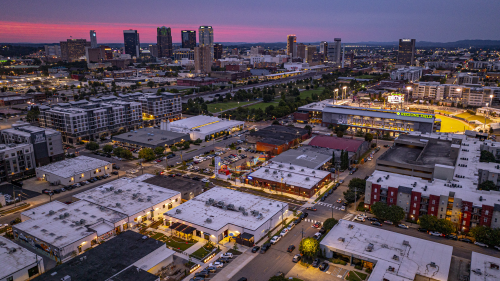Property Types
Hotels and Resorts
The hotel industry in the United States faces complex challenges in 2025, according to Jan Freitag, national director of hospitality analytics for the CoStar Group. During the “State of the U.S. Hotel Industry” presentation at the ULI 2025 Spring Meeting in Denver, Colorado, Freitag highlighted the challenges facing the hotel business amid macroeconomic uncertainty.
Once a sprawling expanse of uncharted land, Las Vegas, Nevada, has evolved into the entertainment capital of the world, a gaming super-hub, and a premier destination for sports. This remarkable transformation didn’t happen overnight; it stemmed from decades of strategic planning, investment, and visionary zoning recommendations.
Las Vegas is unlike any other place in America. Each year it draws more than 40 million visitors to the dazzling casinos and hotels that “turn night into daytime”—and transform the city into a glittering jewel in the desert. With 164,000 hotel rooms, Las Vegas is the largest hospitality market in the U.S.—outpacing Orlando, Florida, the next biggest market, by approximately 15 percent, according to JLL.
Industrial
Standing in the shadow of Regions Field and within earshot of Railroad Park, Birmingham’s Urban Supply hints at what the next chapter of downtown life could look like. Once-quiet brick warehouses are being steadily reimagined into patios, storefronts, and gathering spaces along a new pedestrian alley. Early tenants have begun to open their doors, and programming is slowly bringing people into the district. While the project is still in its early stages, the framework is in place for a vibrant hub that will grow block by block in the years ahead.
What trends are shaping the future of the industrial sector? Four experts from ULI’s Industrial and Office Park Development Council talk about the industrial submarkets and property types that offer the greatest opportunities, challenges developers face in bringing new projects to market, ways artificial intelligence and emerging technologies are reshaping the sector, tenant priorities, and other key trends.
After a quiet first half of 2024, CMBS originations increased 59 percent in Q3 on a year-over-year basis, according to the Mortgage Bankers Association’s Quarterly Survey.
Mixed-Use
New resilience framework touches on infrastructure, economy, equity, housing, and cultural vitality.
The OAK project began in 2009, when a development firm set their sights on the corner of Northwest Expressway and North Pennsylvania Avenue, the state’s most important and busiest retail intersection. As the region’s only parcel capable of supporting a vertically integrated project of this scale and density, that land represented an opportunity to create something truly special.
Following a masterplan adopted by British Land, the AustralianSuper pension fund, and the Southwark Council, developers are now seven years into a 15-year project to transform a 53-acre (21.44 hectares) parcel of industrial land and a former quay into a community that will include as many as 3,000 new homes, office, retail, leisure, and entertainment space.
Multifamily
As congregations across North America grapple with shrinking membership and aging facilities, a new opportunity is emerging: transforming faith-owned land into affordable housing and community-serving spaces. At the 2025 ULI Fall Meeting in San Francisco, panelists in the session “Spiritual Brownfields: Declining Congregations and Opportunities for Housing on Faith-Owned Land” explored how churches and developers are partnering to bring mission-driven housing to underused sacred sites.
At the 2025 ULI Fall Meeting in San Francisco, leaders from across the development and construction industries discussed how they are adapting to a volatile yet stabilizing housing landscape in a session called “Report from the Field: Wrestling with the Cost of Housing Construction.” Despite headlines about tariffs, labor shortages, and inflation, the panelists agreed that the cost environment has settled into what one called a “new normal.”
A panel of insiders reveals what’s true—and false—about the housing crisis and how to fix it.
Office
In the current economic downturn, job prospects in the real estate development industry can seem scarce. However, development has always been about reinvention to meet a constantly changing market. The following ten real estate professionals illustrate a variety of career reinvention possibilities. Listed in alphabetical order, they have all changed jobs within the past five years, taking on a different role in the industry— not necessarily because of the recession, but because they saw new opportunities in a dynamic market. Some have become consultants, some have founded their own firms, some have gone to work in the public sector, and some have joined firms in a related profession. They discuss what drew them to their new jobs, how their previous work informs their current work, and how they are drawing on and broadening their expertise.
The U.N. Climate Change Conference in Copenhagen may have ended without an international commitment to specific greenhouse gas reduction targets, but the development community still needs to prepare to meet stringent targets in the next five to ten years. Both California and the U.K., among others, have already started down the path that the rest of the world is likely to soon follow.
Institutional investors will not be abandoning real estate as an asset class in 2010. Instead, they will be retrenching, rethinking, and carefully dipping their toes back into the water.
Residental
Homes near public transit retained their value better during the recession than their counterparts in auto-dependent areas, according to a recent study. What’s impressive is the extent of it: In five metropolitan areas, residential property values performed 42 percent better on average.
A bipartisan housing commission is calling for the complete elimination of Fannie Mae and Freddie Mac, plus a more targeted Federal Housing Administration that returns to its roots. The panel further says it is time to recognize the country’s changing demographics by placing a stronger federal emphasis on rental housing.
According to a newly released NAHB survey, buyers in 2013 are looking for bigger homes again, but also want energy-efficiency and plenty of storage.
Retail
For decades, civic leaders have tried to revitalize Market Street, San Francisco’s central thoroughfare, only to see their efforts founder. “I sometimes call it the great white whale of San Francisco,” says Eric Tao, managing partner at L37 Development in San Francisco and co-chair of ULI San Francisco. “Every new mayor, every new planning director, every new economic development director has chased that white whale.” This year, however, an international competition of ideas hosted and run by ULI San Francisco, with support from the ULI Foundation, generated fresh momentum for reimagining the boulevard. The competition drew 173 submissions from nine countries and sparked new conversations about the future of downtown San Francisco.
As aging retail continue to evolve, one increasingly popular trend has been to redesign malls as town centers—recalling a time when such commercial districts were the heart and soul of a community. Mall–to–town center retrofits are emerging throughout the nation, especially in suburban communities, where pedestrian-friendly, mixed-use environments are highly attractive to millennials now raising families.
Consumers have kept a steady foot on the gas this year. A record-high 197 million consumers shopped in stores or online over the Thanksgiving holiday weekend, according to the National Retail Federation (NRF). The NRF forecasts that holiday sales will grow between 2.5 percent and 3.5 percent, with total retail spending in the United States falling between $979.5 billion and $989 billion during November and December. That forecast also is consistent with NRF’s annual U.S. sales growth—between 2.5 percent and 3.5 percent—for 2024.

















